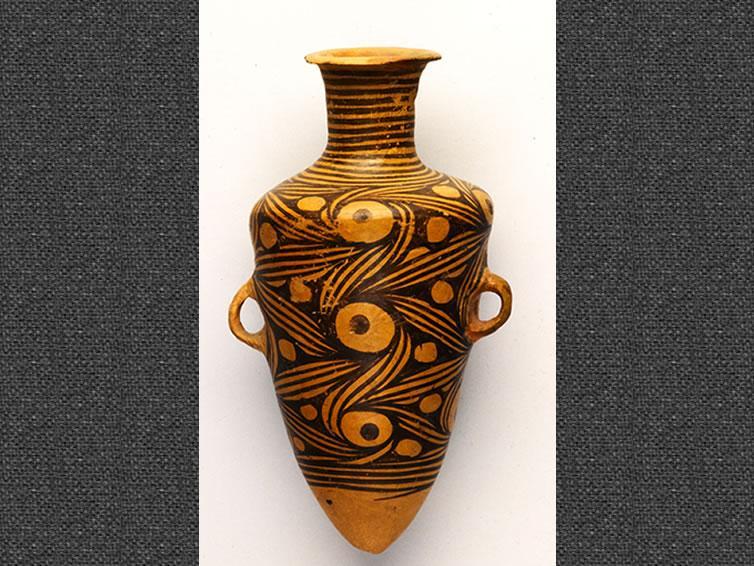Chinese Relics
Whirlpool-Patterned Painted Pottery Bottle with Pointed Bottom

| What is it?
Name: | Whirlpool-Patterned Painted Pottery Bottle with Pointed Bottom |
Historical Period: | c. 5,000 years ago (Majiayao Style of the Majiayao Culture) |
Height: | 26.8 cm, Mouth Diameter: 7.1 cm |
Excavation Site: | Lüjiaping, Longxi County, Gansu Province |
Housed in: | Gansu Provincial Museum |
| What's the story?
The pottery bottle decorated with whirlpool patterns is of the Majiayao Style and marks the peak of the 5,000-year Chinese painted pottery culture in the upper reaches of the Yellow River (e.g. Gansu and Qinghai).
The Majiayao ancestors imaginatively depicted the rushing Yellow River with whirlpool patterns, which represents the highest level of Chinese painted pottery culture and saw the formation and development of the Yellow River civilization in the late stage of the Neolithic Period.
Colorful culture of painted pottery
Archaeologists marveled at the painted pottery bottle: the smooth whirlpool patterns, and the dynamic, powerful lines. Do these patterns reflect the swift currents of the Yellow River?
The bottle's design also well integrates aesthetics and practicality. With two holes on each side, the bottle can be tied with a rope to draw water. With the pointed bottom, water may easily flow into the bottle. Due to the buoyancy and the center of gravity, the bottle can naturally tilt to one side when floating. The narrow mouth prevents water from spilling. All these make the bottle a masterpiece of painted pottery of the Majiayao Culture.
Painted pottery is widely seen in China. In the history of Chinese civilization, the painted pottery culture lasting for more than 5,000 years played a prominent role. It includes such styles as Laoguantai, Yangshao, Majiayao, Dawenkou, Qujialing, Daxi, Hongshan, Qijia and Xindian. In a way, painted pottery culture laid a solid foundation for the Chinese civilization.
Painted pottery of Majiayao Culture
The Majiayao Culture was discovered in 1923, when a Neolithic cultural site at Majiayao Village, Lintao County, Gansu Province surprised the world. Influenced by the Miaodigou Style of the Yangshao Culture in the Central Plains, the Majiayao Culture came into being. With local color, it was regarded as "the Yangshao Culture in Gansu." The Majiayao Culture appeared in the late stage of the Neolithic Period more than 5,700 years ago and lasted for more than 1,000 years.
Characterized by its sophisticated pottery-making techniques, Majiayao painted pottery built upon and enhanced the achievements of Miaodigou Style. With its colorful and elegant style, it represents the highest artistic level of prehistoric Chinese painted pottery.
Emergence of the Majiayao Culture
The demographic factor played an important role in the emergence and formation of the Majiayao Culture. As the productivity of the Yangshao Culture continuously increased, the population pressure intensified. This led to a wave of westward migration. The migrants arrived in the middle and upper reaches of the Yellow River and adapted to the new geographical environment. In more than 1,000 years, they created a brilliant dry farming culture and advanced the development of the Yellow River civilization.
Source: Becoming the Chinese Nation: The historical memories of multi-ethnic Chinese Nation in 100 cultural relics
Liu Xian /Editor Chi Jianfeng /Translator
Yang Xinhua /Chief Editor Ren Qiang /Coordinator
Liu Li /Reviewer
Zhang Weiwei /Copyeditor Tan Yujie /Image Editor
The views don't necessarily reflect those of DeepChina.
